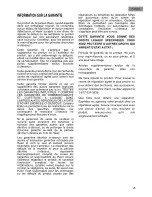
58
LC-32LE631
LC-40LE631
LC-46LE631
•
+5V-TUN supply voltage (5V nominal) for tuner and IF
amplifier.
+3V3-STANDY (3V3 nominal) is the permanent voltage,
supplying the Stand-by microprocessor inside PNX855xx.
Supply v1V1 is started immediately when +12V voltage
becomes available (+12V is enabled by STANDBY signal when
"low"). Supply vo3V3, +2V5, +1V8, +1V2 and +5V-TUN
are switched "on" by signal ENABLE-3V3 when "low", provided
that +12V (detected via 7U40 and 7U41) is present.
+12V is considered OK (=> DETECT2 signal becomes "high",
+12V to +1V8, +12V to +3V3, +12V to +5V DC-DC converter
can be started up) if it rises above 10V and doesn’t drop below
9V5. A small delay of a few milliseconds is introduced between
the start-up of 12V to +1V8 DC-DC converter and the two other
DC-DC converters via 7U48 and associated components.
Description DVB-S2:
•
LNB-RF1 (0V = disabled, 14V or 18V in normal operation)
LNB supply generated via the second conversion channel
of 7T03 followed by 7T50 LNB supply control IC. It provides
supply voltage that feeds the outdoor satellite reception
equipment.
•
+3V3-DVBS (3V3 nominal), +2V5-DVBS (2V5 nominal)
and +1V-DVBS (1.03V nominal) power supply for the
silicon tuner and channel decoder. +1V-DVBS is generated
via a 5V to 1V DC-DC converter and is stabilized at the
point of load (channel decoder) by means of feedback
signal SENSE+1V0-DVBS. +3V3-DVBS and +2V5-DVBS
are generated via linear stabilizers from +5V-DVBS that by
itself is generated via the first conversion channel of 7T03.
At start-up, +24V becomes available when STANDBY signal is
"low" (together with +12V for the basic board), when +3V3 from
the basic board is present the two DC-DC converters channels
inside 7T03 are activated. Initially only the 24V to 5V converter
(channel 1 of 7T03 gene5V-DVBS) will effectively work,
while +V-LNB is held at a level around 11V7 via diode 6T55.
After 7T05 is initialized, the second channel of 7T03 will start
and generates a voltage higher then LNB-RF1 with 0V8. +5V-
DVBS start-up will imply +3V3-DVBS start-up, with a small
delay of a few milliseconds => +2V5-DVBS and +1V-DVBS will
be enabled.
If +24V drops below +15V level then the DVB-S2 supply will
stop, even if +3V3 is still present.
Debugging
The best way to find a failure in the DC/DC converters is to
check their start-up sequence at power “on” via the mains cord,
presuming that the stand-by microprocessor and the external
supply are operational. Take STANDBY signal "high"-to-"low"
transition as time reference.
When +12V becomes available (maximum 1 second after
STANDBY signal goes "low") then +1V1 is started immediately.
After ENABLE-3V3 goes "low", all the other supply voltages
should rise within a few milliseconds.
Tips
•
Behaviour comparison with a reference TV550 platform
can be a fast way to locate failures.
•
If +12V stays "low", check the integrity of fuse 1U40.
•
Check the integrity (at least no short circuit between drain
and source) of the power MOS-FETs before starting up the
platform in SDM, otherwise many components might be
damaged. Using a ohmmeter can detect short circuits
between any power rail and ground or b12V and
any other power rail.
•
Short circuit at the output of an integrated linear stabilizer
(7UC0, 7UD2 or 7UD3) will heat up this device strongly.
•
Switching frequencies should be 500 kHz ...600 kHz for
12 V to 1.1 V and 12 V to 1.8 V DC-DC converters,
5.8.2
Audio Amplifier
The Class D-IC 7D10 has a powerpad for cooling. When the IC
is replaced it must be ensured that the powerpad is very well
pushed to the PWB while the solder is still liquid. This is needed
to insure that the cooling is guaranteed, otherwise the Class D-
IC could break down in short time.
5.8.3
AV PIP
To check the AV PIP board (if present) functionality, a
dedicated tespattern can be invoke as follows: select the
“multiview” icon in the User Interface and press the “OK”
button. Apply for the main picture an extended source, e.g.
HDMI input. Proceed by entering CSM (push ‘123654’ on the
remote control) and press the yellow button. A coloured
testpattern should appear now, generated by the AV PIP board
(this can take a few seconds).
5.8.4
CSM
When CSM is activated and there is a USB stick connected to
the TV, the software will dump the complete CSM content to the
USB stick. The file (Csm.txt) will be saved in the root of the USB
stick. If this mechanism works it can be concluded that a large
part of the operating system is already working (MIPS, USB...)
5.8.5
DC/DC Converter
Description basic board
The basic board power supply consists of 4 DC/DC converters
and 5 linear stabilizers. All DC/DC converters have +12V input
voltage and deliver:
•
+1V1 supply voltage (1.15V nominal), for the core voltage
of PNX855xx, stabilized close to the point of load;
SENSE+1V1 signal provides the DC-DC converter the
needed feedback to achieve this.
•
+1V8 supply voltage, for the DDR2 memories and DDR2
interface of PNX855xx.
•
+3V3 supply voltage (3.30V nominal), overall 3.3 V for
onboard IC’s, for non-5000 series SSB diversities only.
•
+5V (5.15V nominal) for USB, WIFI and Conditional
Access Module and +5V5-TUN for +5V-TUN tuner
stabilizer.
The linear stabilizers are providing:
•
+1V2 supply voltage (1.2V nominal), stabilized close to
PNX855xx device, for various other internal blocks of
PNX855xx; SENSE+1V2 signal provides the needed
feedback to achieve this.
•
+2V5 supply voltage (2.5V nominal) for LVDS interface and
various other internal blocks of PNX855xx; for 5000 series
SSB diversities the stabilizer is 7UD2 while for the other
diversities 7UC0 is used.
•
+3V3 supply voltage (3V3 nominal) for 5000 series SSB
diversities, provided by 7UD3; in this case the 12V to 3V3
DC-DC converter is not present.
5.8
Fault Finding and Repair Tips
Read also section “
5.5 Error Codes
,
5.5.4 Error Buffer
,
Extra
Info
”.
Service Modes, Error Codes, and Fault Finding (continued)
631
631
631
















































